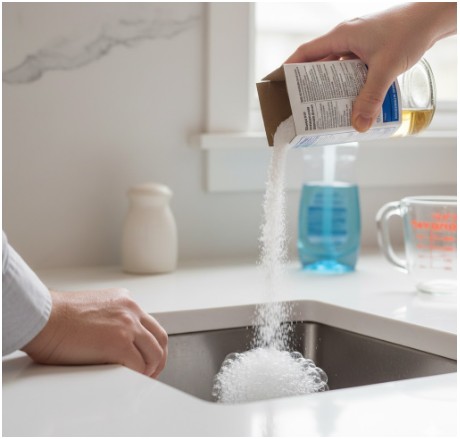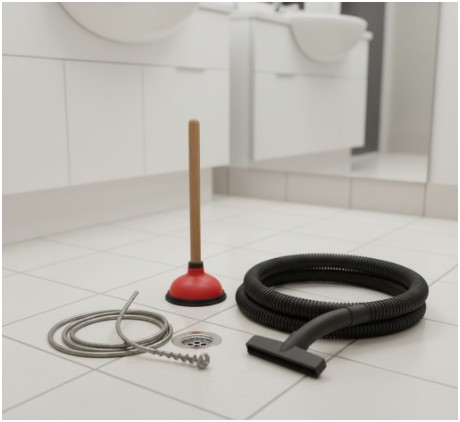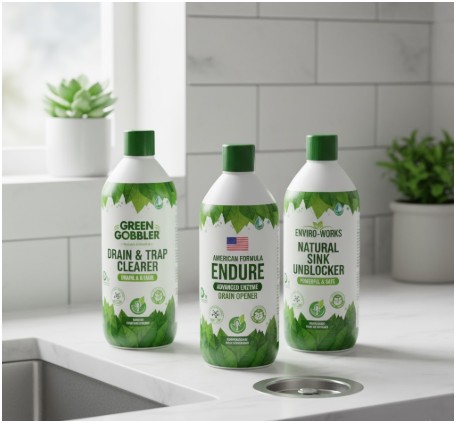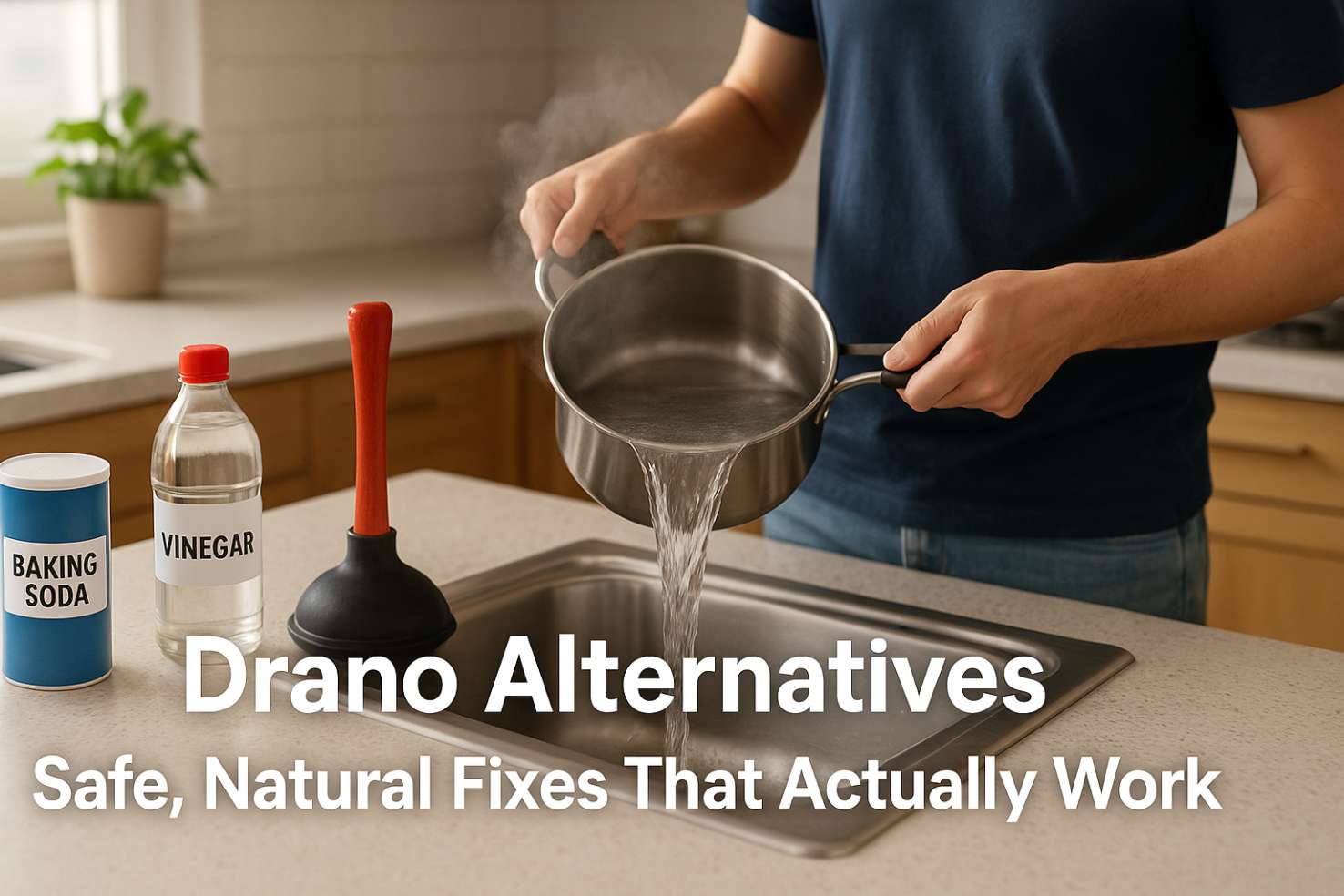The first time my sink refused to drain, I did what most people do—I grabbed a bottle of Drano. The results were fine at first, but weeks later, I noticed a faint chemical smell and my pipes started creaking like a haunted house. That’s when I learned the hard way: harsh chemicals aren’t always the answer. Since then, I’ve experimented with Drano alternatives that are safer, cheaper, and surprisingly effective.
Here’s my personal playbook for unclogging drains using DIY mixtures, simple tools, and enzyme-based products that actually get the job done—without melting your pipes or your nose hairs.
What Are the Best DIY Drano Alternatives for Clogged Drains?

When you’re facing a sluggish drain, chances are the culprit is grease, soap scum, or food residue. Thankfully, your pantry probably has everything you need to tackle it.
- Baking Soda and Vinegar
This classic combo is a fizzy miracle for minor clogs. I pour half a cup of baking soda into the drain, chase it with half a cup of white vinegar, and watch the magic happen. After about 30 minutes, I flush it all down with a pot of boiling water. It’s safe, satisfying, and oddly therapeutic to hear that “whoosh” sound as the clog disappears.
- Salt, Baking Soda, and Vinegar for Tougher Clogs
When basic fizz isn’t enough, I add half a cup of salt to the baking soda before pouring it down the drain. Let it sit for half an hour, then pour boiling water over it. If I’m feeling extra stubborn (and the clog is too), I add half a cup of vinegar to the mix for an extra punch.
- Hydrogen Peroxide and Baking Soda
This bubbly duo is a great deodorizer and gentle cleaner. I mix one cup of hydrogen peroxide with a tablespoon of baking soda, pour it down, and let it sit for 15 minutes before rinsing with hot water. It not only clears small blockages but also leaves the drain smelling surprisingly fresh.
- Dish Soap and Boiling Water
When grease is the main villain—especially in kitchen sinks—nothing beats boiling water and dish soap. I pour a generous amount of soap, then follow it up with a pot of boiling water. The heat melts the grease while the soap breaks it apart. Simple science, big results.
How Do Mechanical Tools Stack Up Against Drano Alternatives?

Sometimes, no amount of fizz or foam will fix a stubborn clog. That’s when I reach for good old-fashioned tools. They require a bit more elbow grease, but they’ve saved me countless plumber calls.
The Plunger Power Move
A plunger works wonders if used right. I make sure there’s enough water to cover the plunger’s rim and press down firmly to create suction. For double sinks, I plug the other side with a wet rag to increase pressure. It’s oddly satisfying when you finally feel the clog give way.
Drain Snake or Auger
A drain snake is my go-to for hair and deep clogs. I insert the flexible cable, twist, and pull—like fishing, but for gunk. If I don’t have a snake handy, I straighten a wire hanger, bend a small hook at the end, and pull out the mess. It’s not glamorous, but it’s oddly effective.
Wet/Dry Vacuum
This one’s a power move if you have access to a shop vac. Set it to the liquid setting, cover the vent, and let it suck out the blockage. You’ll hear the clog pop free, and yes—it’s gross, but it works.
Are Enzymatic Cleaners Worth the Hype?

After experimenting with homemade fixes, I wanted to try eco-friendly Drano alternatives that could handle tougher clogs without chemicals. That’s when I discovered enzymatic cleaners—nature’s little pipe janitors.
These cleaners use live enzymes that literally eat away at organic waste like hair, grease, and food residue. They’re non-toxic, biodegradable, and gentle on both metal and PVC pipes.
Here are a few I’ve personally tested:
| Brand | Highlights | Why I Like It |
| American Formula Endure | Great for grease-heavy kitchen drains | Worked wonders without harsh smells |
| Green Gobbler Drain Clog Dissolver | Fast-acting enzyme solution | Cleared my bathroom drain in under an hour |
| Enviro-Works Natural Sink & Drain Unblocker | Pet-safe probiotic formula | Ideal for maintenance and odor control |
Unlike chemical drain cleaners, enzymatic ones don’t corrode or overheat your pipes. They take a little longer to work, but I’ll take “safe and steady” over “instant and damaging” any day.
How Can I Prevent Clogs Without Relying on Drano Alternatives Every Week?
After too many “oh no” sink moments, I’ve learned that prevention is the real fix. Keeping drains clear takes just a few small habits:
Use Drain Strainers: These cheap mesh guards catch hair and food scraps before they become a problem. I keep one in every sink and shower.
Regular Hot Water Flushes: Once a week, I pour a kettle of boiling water down the drain. It melts away minor grease buildup before it has a chance to settle.
Avoid Pouring Grease Down the Drain: Instead, I collect cooking oil in a jar and toss it once full. Trust me—it’s easier than unclogging a sink at 11 p.m.
These habits, combined with the natural methods above, have kept my drains running smoothly for months without a single call to a plumber.
How to Use Drano Alternatives Step-by-Step
Here’s my go-to DIY drain cleaning routine that’s worked in countless situations:
- Start with Baking Soda and Vinegar. Pour ½ cup baking soda, then ½ cup vinegar. Let it fizz for 30 minutes.
- Add Boiling Water. Flush with a pot of boiling water to wash everything away.
- Try the Plunger Next. If the water still drains slowly, use a plunger to build suction pressure.
- Snake It Out. For stubborn clogs, insert a drain snake or hanger hook to remove hair or food debris.
- Finish with an Enzymatic Cleaner. Use a product like Green Gobbler overnight for a deep, natural clean.
This layered approach covers everything—chemical-free, effective, and safe for your plumbing.
FAQs About Drano Alternatives
1. Do Drano alternatives really work on tough clogs?
Yes! For stubborn blockages, combining methods (like baking soda/vinegar followed by a drain snake) works best. Enzymatic cleaners are slower but very effective for organic buildup.
2. Are these methods safe for all pipes?
Absolutely. Unlike Drano, which can corrode PVC or older metal pipes, these alternatives rely on mild reactions or natural enzymes, making them safe for all plumbing types.
3. How often should I clean my drains?
Once a week for maintenance is ideal. Even just a hot water flush can prevent buildup from turning into a clog.
4. Can I use these in a garbage disposal or shower drain?
Yes—just skip large debris. Baking soda, vinegar, and enzymatic cleaners work great in disposals and showers. Just avoid plunging directly into a disposal unit.
The Final Flush (Because Every Clog Has Its Day)
I used to think drain cleaning meant choosing between harsh chemicals and expensive plumbers. Now I know better—Drano alternatives can do the same job, often better, without ruining pipes or the planet.
My tip? Treat your drains like you would your car—maintain them before they break down. A little fizz, some patience, and the right tools will keep your sinks and tubs happy for years.
Next time your drain groans in protest, skip the neon bottle and grab your baking soda instead. Your pipes (and your wallet) will thank you.









